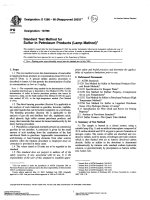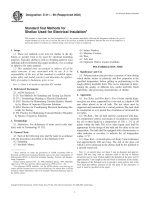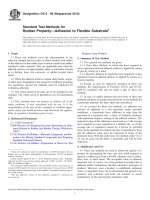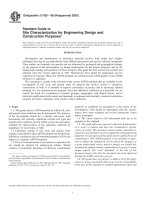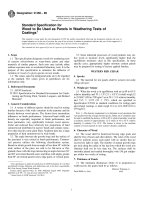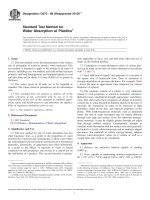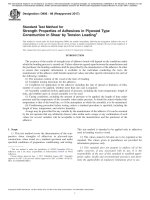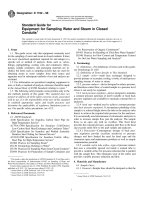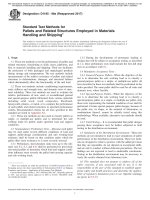Astm d 358 98
Bạn đang xem bản rút gọn của tài liệu. Xem và tải ngay bản đầy đủ của tài liệu tại đây (32.53 KB, 3 trang )
Designation: D 358 – 98
AMERICAN SOCIETY FOR TESTING AND MATERIALS
100 Barr Harbor Dr., West Conshohocken, PA 19428
Reprinted from the Annual Book of ASTM Standards. Copyright ASTM
Standard Specification for
Wood to Be Used as Panels in Weathering Tests of
Coatings1
This standard is issued under the fixed designation D 358; the number immediately following the designation indicates the year of
original adoption or, in the case of revision, the year of last revision. A number in parentheses indicates the year of last reapproval. A
superscript epsilon (e) indicates an editorial change since the last revision or reapproval.
This standard has been approved for use by agencies of the Department of Defense.
1. Scope
1.1 This specification designates woods for weathering tests
of exterior solvent-borne or water-borne paints and other
materials of similar purpose. Such tests may include either
outdoor exposure tests or accelerated laboratory tests. It is the
purpose of this specification to minimize the influence of
variation of wood of a given species on test results.
1.2 The values stated in inch/pound units are to be regarded
as the standard. The values given in parentheses are for
information only.
3.3 Some industrial processors of wood products may utilize wood at moisture levels significantly higher than the
equilibrium moistures cited in this specification. In these
specific cases, appropriately higher moisture content panels
may be prepared for testing of factory applied finishes.
2. Referenced Documents
2.1 ASTM Standards:
D 3924 Specification for Standard Environment for Conditioning and Testing Paint, Varnish, Lacquers, and Related
Materials2
5. Weight per Volume
5.1 When the wood is in equilibrium with air at 60 to 65 %
relative humidity and 70 6 1°F (21 6 0.5°C) it shall weigh 22
to 23 lb/ft3 (350 to 370 kg/m3) or at 50 6 5 % relative humidity
and 73.5 6 3.5°F (23 6 2°C), which are specified in
Specification D 3924 as standard conditions for testing paint
and related coatings, it shall weigh 21.4 to 22.4 lb/ft3(343 to
359 kg/m3).
WESTERN RED CEDAR
4. Species
4.1 The material for test panels shall be western red cedar
(Thuja plicata).
3. General Considerations
3.1 A variety of different species should be used for testing
finishes because of the wide variations in the anatomy and the
density between wood species. The factors have tremendous
influences on finish performance. Latewood band width and
density are especially important to finish performance, and
these parameters vary significantly between wood species.
Cedar and redwood have relatively low proportions of hard
summerwood distributed in narrow bands and contain extractives that discolor some paint films. Southern pine has a large
proportion of hard summerwood in wide bands.
3.2 The angle between the growth rings and the surface of
the specimen is very critical to finish performance. Commercial practice utilizes the following classification system.
Boards in which growth form an angle of less than 30° with the
wide surface of the piece are said to be flat-sawn or flatgrained; those with the rings intersecting at angles between 30°
and 60° are termed bastard-sawn; and those with angles greater
than 60° are termed quarter-sawn, edge grain, or vertical grain.
NOTE 1—The density requirement is to eliminate wood specimens that
vary greatly from the average for that species. Either set of conditions may
be used to establish the density. At 60 to 65 % relative humidity wood has
a moisture content of approximately 12 % while at 45 to 55 % relative
humidity it contains 9 to 10 %. The former is closer to the moisture
content of wood exposed to most exterior climatic conditions.
6. Character of Wood
6.1 The wood shall be heartwood having edge grain and
shall be free of knots and other defects. The color of the wood
shall be uniform across each panel with no streaks that are
excessively light or dark. The number of annual growth rings
per inch along the radius of the log from which the wood was
obtained shall not be less than ten. The surfaces shall be
smoothly planed and sanded thoroughly with 150 grit sandpaper within two weeks of testing.
7. Thickness of Panels
7.1 The minimum thicknesses (Note 2) in proportion to
width (across the grain) shall be as follows:
1
This specification is under the jurisdiction of ASTM Committee D-1 on Paint
and Related Coatings, Materials, and Applications and is the direct responsibility
D01.52on Factory-Coated Wood Products.
Current edition approved May 10, 1998. Published August 1998. Originally
published as D 358 – 33. Last previous edition D 358 – 93.
2
Annual Book of ASTM Standards, Vol 06.01.
Panel Width, in. (mm)
1
Minimum Thickness, in.
(mm)
D 358
Less than 3 (less than 75)
3 to 6 (75 to 150)
Over 6 (over 150)
other defects. The color of the wood shall be uniform across
each panel with no streaks that are excessively light or dark.
The number of annual growth rings per inch along the radius of
the log from which the wood was obtained shall be not less
than 4 nor more than 12. The surfaces shall be smoothly planed
and sanded thoroughly with 150 grit sandpaper within two
weeks of testing.
14.2 The wood shall be sapwood having flat grain.
⁄ (10)
⁄ (11)
3⁄4 (19)
38
7 16
NOTE 2—Minimum thicknesses in proportion to width (across the
grain) do not apply to panels made of clapboard or siding of commercial
types, which shall be used as regularly marketed.
WHITE PINE AND PONDEROSA PINE
8. Species
8.1 White pine wood shall be northern white pine (Pinus
strobus). Western white pine (Pinus monticola), or sugar pine
(Pinus lambertiana). Western white pine is sometimes called
Idaho white pine. Ponderosa pine wood shall be Pinus ponderosa.
15. Thickness of Panels
15.1 The minimum thicknesses (see Note 3) in proportion to
width (across the grain) shall be as follows:
7 16
7 16
34
REDWOOD
16. Species
16.1 The material for test panels shall be redwood (Sequoia
sempervirens).
10. Character of Wood
10.1 The wood shall be free of knots, pitch pockets, and
other defects. The color of the wood shall be uniform across
each panel with no streaks that are excessively light or dark.
The number of annual growth rings per inch along the radius of
the log from which the wood was obtained shall be not less
than 15. The surfaces shall be smoothly planed and sanded
thoroughly with 150 grit sandpaper within two weeks of
testing.
10.2 The wood shall be selected as edge grain or flat grain
as desired. The test surface of flat grain wood shall be on the
bark side.
17. Weight per Volume
17.1 When the wood is in equilibrium with air at 60 to 65 %
relative humidity and 70 6 1°F (21 6 0.5°C) it shall weigh 28
to 29 lb/ft3 (450 to 460 kg/m3) or at 50 6 5 % relative humidity
and 73.5 6 3.5°F (23 6 2°C) it shall weigh 27.2 to 28.2 lb/ft3
(436 to 452 kg/m3). (See Note 1.)
18. Character of Wood
18.1 The material shall be heartwood, as nearly edge grain
as possible. The number of annual growth rings per inch along
the radius of the log from which the wood was obtained shall
be not less than 18. The wood shall be free of knots, oil streaks,
and other defects such as wavy burl grain. The color of the
wood shall be uniform across each panel with no streaks that
are excessively light or dark. The surfaces shall be smoothly
planed and sanded thoroughly with 150 grit sandpaper within
two weeks of testing.
11. Thickness of Panels
11.1 The minimum thicknesses (see Note 3) in proportion to
width (across the grain) shall be as follows:
Minimum Thickness, in.
(mm)
⁄ (11)
⁄ (11)
3⁄4 (19)
Less than 3 (less than 75)
3 to 6 (75 to 150)
Over 6 (over 150)
⁄ (11)
⁄ (11)
⁄ (19)
Less than 3 (less than 75)
3 to 6 (75 to 150)
Over 6 (over 150)
9. Weight per Volume
9.1 When the wood is in equilibrium with air at 60 to 65 %
relative humidity and 70 6 1°F (21 6 0.5°C) it shall weigh 23
to 27 lb/ft3 (370 to 430 kg/m3) or at 50 6 5 % relative humidity
and 73.5 6 3.5°F (23 6 2°C) it shall weigh 22.4 to 26.4 lb/ft3
(359 to 423 kg/m3). (See Note 1.)
Panel Width, in. (mm)
Minimum Thickness, in.
(mm)
Panel Width, in. (mm)
7 16
7 16
19. Thickness of Panels
19.1 The minimum thicknesses (see Note 2) in proportion to
width (across the grain) shall be as follows:
SOUTHERN PINE
12. Species
12.1 The material for test panels shall be southern pine
(Pinus sp.), suitable for siding purposes. It is not to be limited
to a single species, but shall conform to the requirements
prescribed in Sections 13 and 14.
Panel Width, in. (mm)
Minimum Thickness, in.
(mm)
⁄ (10)
⁄ (11)
⁄ (19)
Less than 3 (less than 75)
3 to 6 (75 to 150)
Over 6 (over 150)
13. Weight per Volume
13.1 When the wood is in equilibrium with air at 60 to 65 %
relative humidity and 70 6 1°F (21 6 0.5°C) it shall weigh 32
to 38 lb/ft3 (510 to 610 kg/m3) or at 50 6 5 % relative humidity
and 73.5 6 3.5°F (23 6 2°C) it shall weigh 31 to 37 lb/ft3(500
to 590 kg/m3). (See Note 2.)
38
7 16
34
DOUGLAS FIR
20. Species
20.1 The material for test panels shall be Douglas fir
(Pseudotsuga menziesii).
21. Weight per Volume
21.1 When the wood is in equilibrium with air at 60 to 65 %
relative humidity and 70 6 1°F (21 6 0.5°C) it shall weigh 30
14. Character of Wood
14.1 The wood shall be free of knots, pitch pockets, and
2
D 358
to 36 lb/ft3 (480 to 580 kg/m3) or at 50 6 5 % relative humidity
and 73.5 6 3.5°F (23 6 2°C) it shall weigh 29 to 35 lb/ft3 (460
to 560 kg/m3). (See Note 1.)
shall be on the bark side.
22. Character of Wood
22.1 The wood shall be free of knots, pitch pockets, and
other defects. The color of the wood shall be uniform across
each panel with no streaks that are excessively light or dark.
The number of annual growth rings per inch along the radius of
the log from which the wood was obtained shall be not less
than ten. The surfaces shall be smoothly planed and sanded
thoroughly with 150 grit sandpaper within two weeks of
testing.
22.2 The wood shall be heartwood and selected as edge
grain or flat grain as desired. The test surface of flat grain wood
23.1 The minimum thicknesses (see Note 2) in proportion to
width (across the grain) shall be as follows:
23. Thickness of Panels
Panel Width, in. (mm)
Less than 3 (less than 75)
3 to 6 (75 to 150)
Over 6 (over 150)
Minimum Thickness, in.
(mm)
⁄ (11)
⁄ (11)
3⁄4 (19)
7 16
7 16
24. Keywords
24.1 weathering; wood coatings; wood panels
The American Society for Testing and Materials takes no position respecting the validity of any patent rights asserted in connection
with any item mentioned in this standard. Users of this standard are expressly advised that determination of the validity of any such
patent rights, and the risk of infringement of such rights, are entirely their own responsibility.
This standard is subject to revision at any time by the responsible technical committee and must be reviewed every five years and
if not revised, either reapproved or withdrawn. Your comments are invited either for revision of this standard or for additional standards
and should be addressed to ASTM Headquarters. Your comments will receive careful consideration at a meeting of the responsible
technical committee, which you may attend. If you feel that your comments have not received a fair hearing you should make your
views known to the ASTM Committee on Standards, 100 Barr Harbor Drive, West Conshohocken, PA 19428.
3
